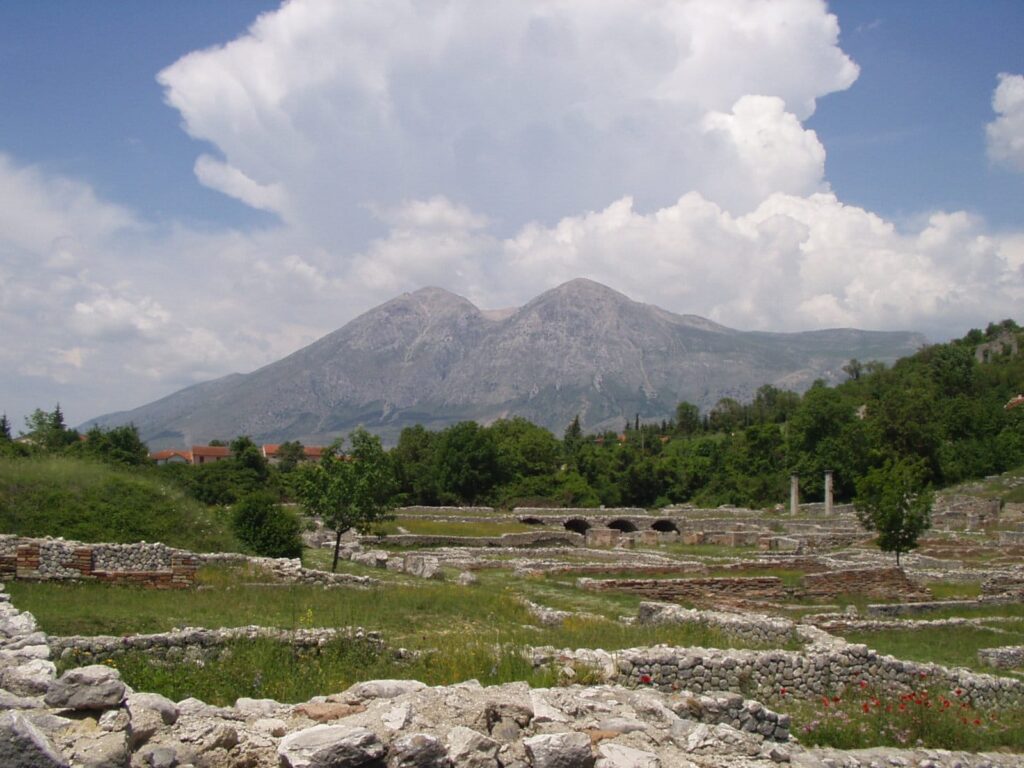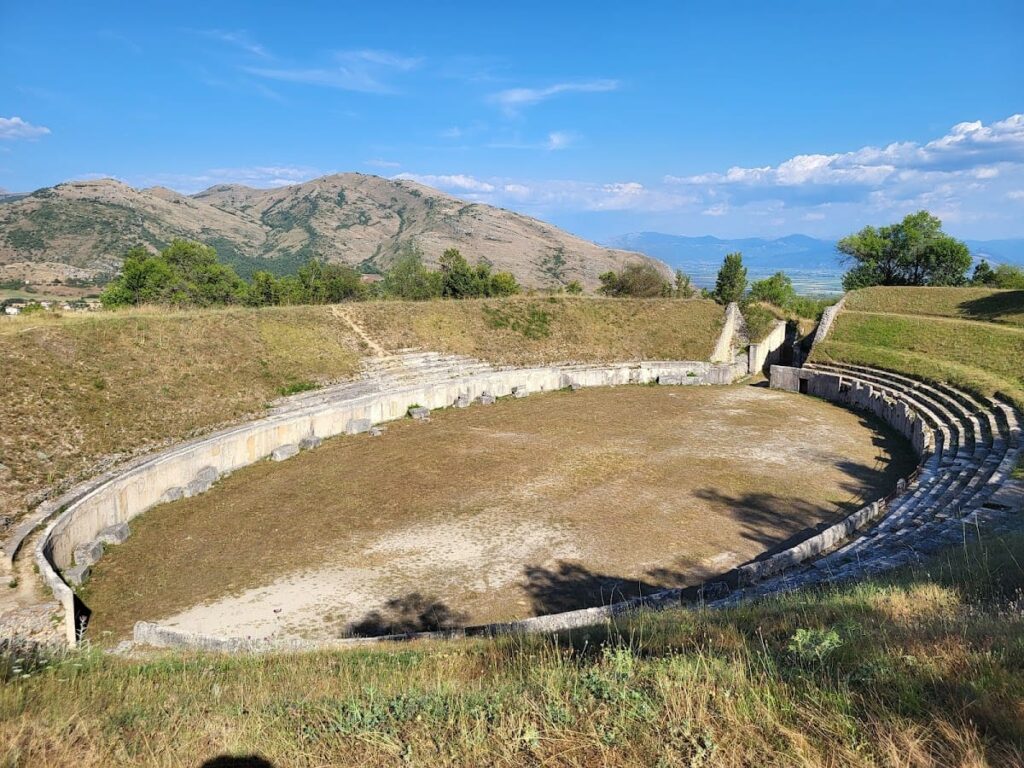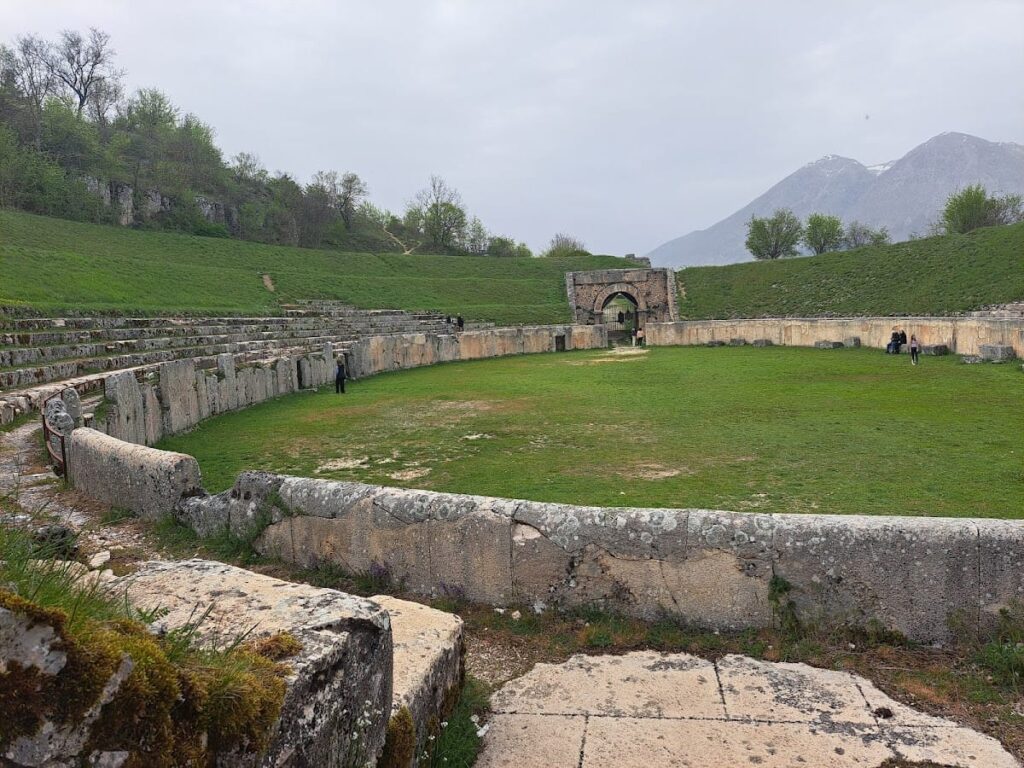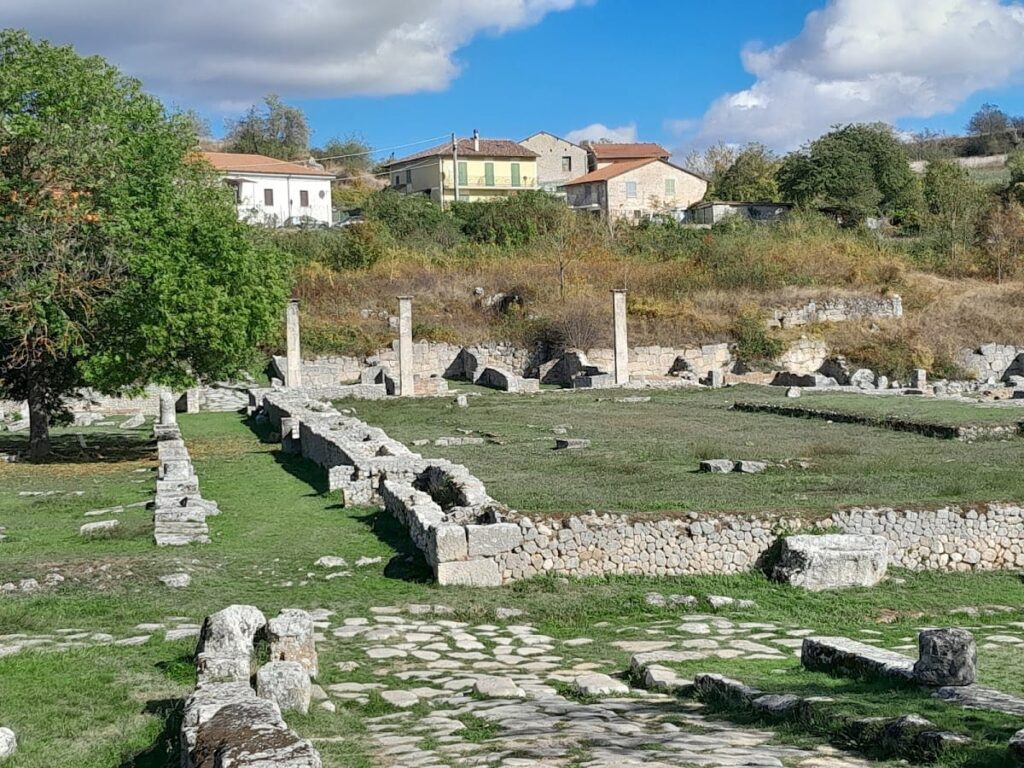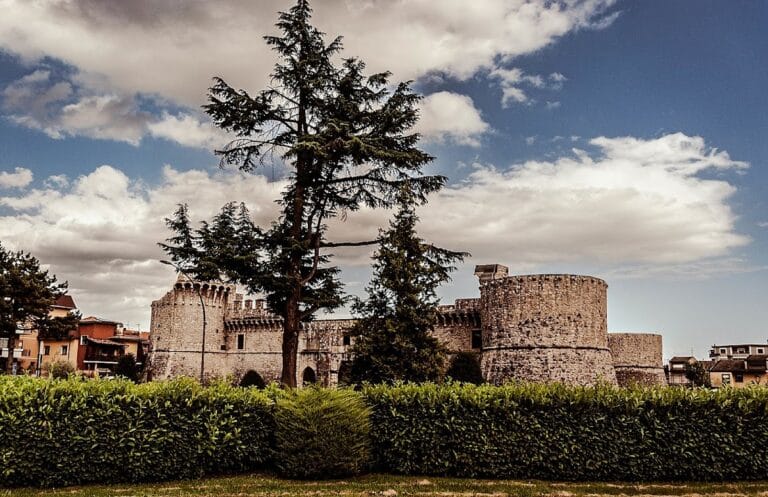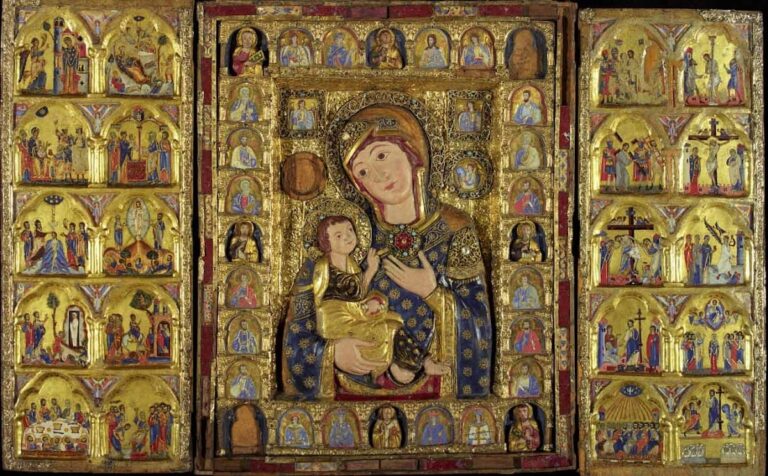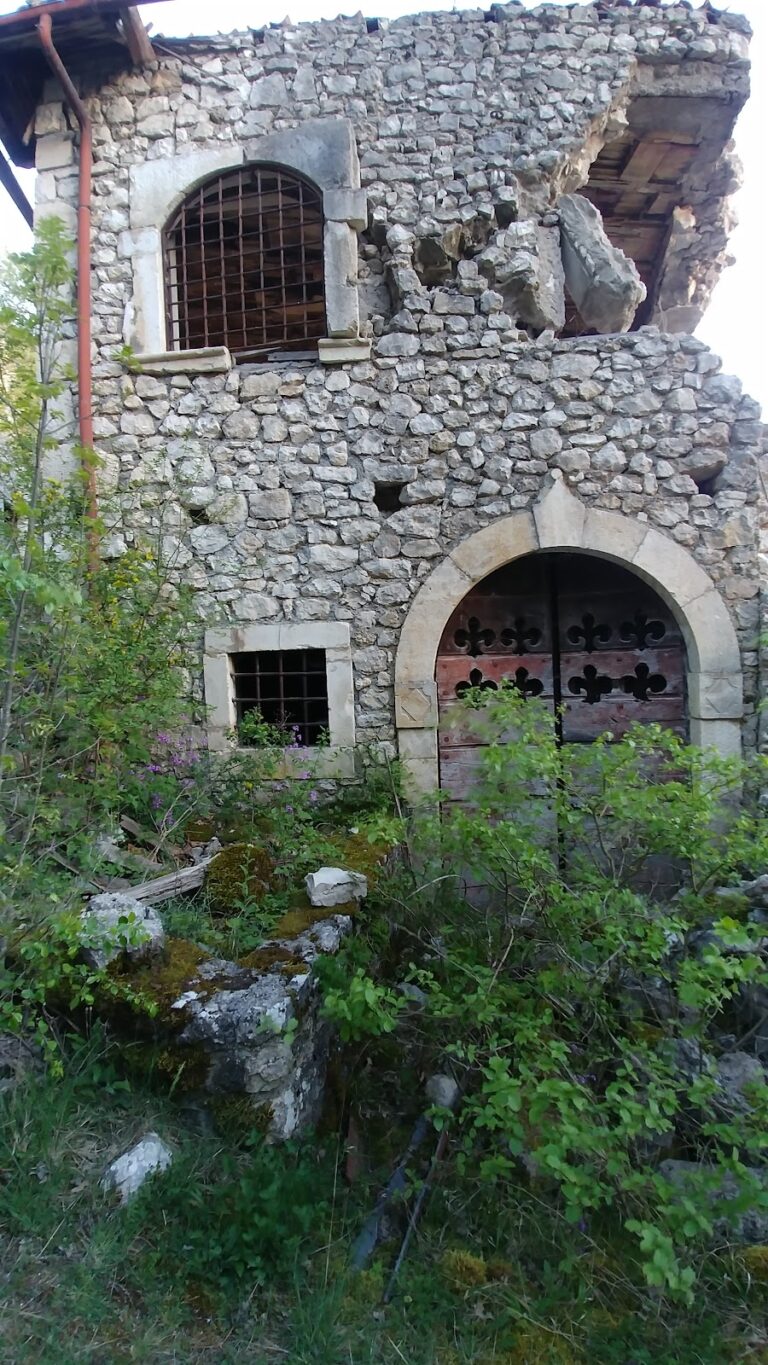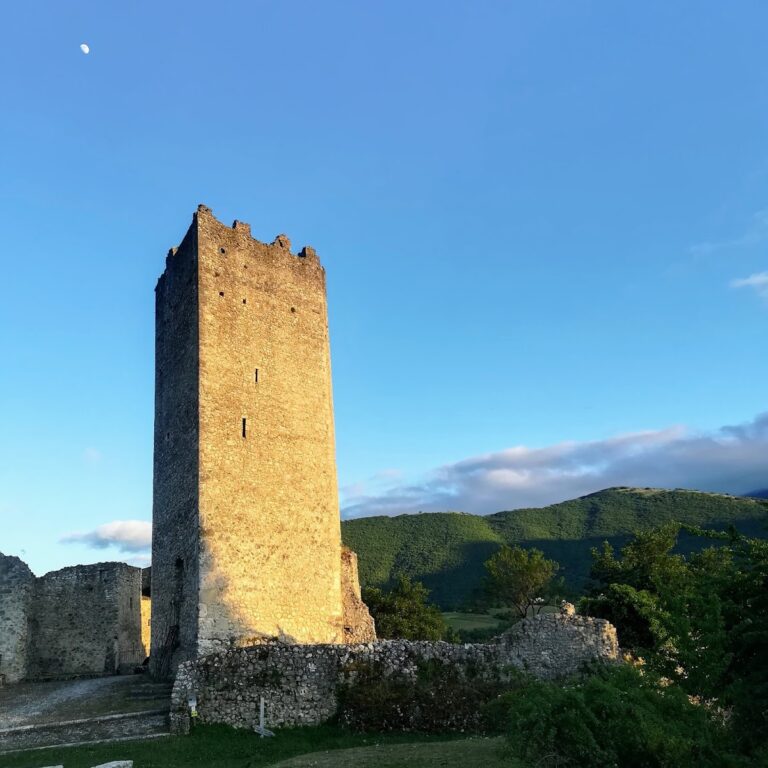Alba Fucens: A Roman Colonial Town in Central Italy
Table of Contents
Visitor Information
Google Rating: 4.6
Popularity: Medium
Google Maps: View on Google Maps
Official Website: www.albafucens.info
Country: Italy
Civilization: Roman
Remains: Burial, City, Civic, Domestic, Economic, Entertainment, Infrastructure, Military, Religious, Sanitation
Context
Alba Fucens is situated in the Abruzzo region of central Italy, near the contemporary town of Massa d’Albe within the province of L’Aquila. The archaeological site occupies a commanding plateau on the slopes of the Apennine Mountains, overlooking the basin of the former Lake Fucinus. This elevated position provided natural defensive advantages and facilitated control over the surrounding fertile plains and mountain passes. The landscape’s rugged topography influenced the settlement’s urban layout and its connections with neighboring communities.
Originally inhabited by Italic peoples such as the Aequi and Marsi, Alba Fucens was later established as a Roman colony in 303 BCE. The site maintained continuous occupation through the Roman Republic and Imperial periods, functioning as both a military stronghold and an agricultural center. Archaeological evidence indicates a gradual decline in settlement activity following the late Roman era, likely linked to broader demographic and political changes in the Apennine region during the early medieval period. Excavations have not identified a singular cause for this decline.
Systematic archaeological investigations began in the 19th century, revealing well-preserved elements of the Roman town’s orthogonal street plan, fortifications, and public architecture. These findings have contributed significantly to the study of Roman colonial urbanism and military architecture in central Italy. Today, Alba Fucens is protected as an archaeological park, with ongoing conservation and research efforts aimed at preserving its extensive remains.
History
Alba Fucens holds considerable historical significance as a strategic settlement in central Italy, reflecting the region’s complex interactions between indigenous Italic peoples and Roman expansion. Initially occupied by the Aequi or Marsi, the site was incorporated into the Roman state as a Latin colony in 303 BCE, serving as a fortified outpost to secure the Apennine passes and fertile lands near Lake Fucinus. Over subsequent centuries, Alba Fucens played a key role in military, administrative, and agricultural networks within the Roman Republic and Empire. Its decline after the late antique period corresponds with widespread depopulation and political fragmentation in the Apennine region during the early medieval era.
Pre-Roman and Early Roman Period (Before 303 BCE – 3rd Century BCE)
Prior to Roman colonization, Alba Fucens was a settlement of the Aequi or Marsi, Italic peoples inhabiting the central Apennines. These groups maintained autonomous communities characterized by clan-based social structures and controlled strategic mountain passes. The site’s location on a rocky hill near Lake Fucinus provided both defensive advantages and access to natural resources. Archaeological evidence, including polygonal (Cyclopean) masonry walls dating to the mid-3rd century BCE, attests to the settlement’s fortified character. These walls, constructed with carefully jointed and smoothed large stone blocks, are comparable to those found in other central Italian towns such as Alatri and Segni.
Following Rome’s military campaigns against the Aequi and Marsi, Alba Fucens was established as a Latin colony in 303 BCE, with approximately 6,000 colonists settled to secure the region. The colony’s foundation was part of Rome’s broader strategy to consolidate control over central Italy after the Samnite Wars. The newly founded settlement immediately constructed defensive walls and successfully repelled Aequi attacks, underscoring its military importance. Ancient authors such as Livy reference Alba Fucens in the context of Roman military operations, highlighting its role as a frontier stronghold guarding the approaches to the Fucine basin.
Roman Republic and Early Imperial Period (3rd Century BCE – 2nd Century CE)
Throughout the late Republic, Alba Fucens functioned as a Roman colony with a dual military and agricultural role. Its location near the Via Valeria Tiburtina, a principal road connecting Rome to the Adriatic coast, and at the junction with routes linking Southern Etruria to Campania via the Liri valley, reinforced its strategic significance. The city’s fortifications were maintained and expanded, reflecting its defensive function during periods of unrest such as the Social War (91–88 BCE), when it remained loyal to Rome despite regional revolts. Literary sources including Livy, Strabo, and Cicero attest to Alba Fucens’ military loyalty and its use as a detention site for prominent prisoners such as King Perseus of Macedonia and Syphax of Numidia.
Urban development during this period followed a Hippodamian orthogonal grid plan, with principal streets including the decumanus (Via Valeria) and cardo, and a secondary street known as Via dei Pilastri. The forum, measuring approximately 142 by 44 meters, served as the civic center, flanked by a basilica, market (macellum), baths, and the Sanctuary of Hercules. Public buildings predominantly date to the late Republican era, with baths enlarged during the Imperial period. The amphitheatre, constructed under Emperor Tiberius and financed by native prefect Naevius Sutorius Macro, exemplifies the city’s integration into Roman cultural and political life. The city’s economy relied on orchards of almonds and other fruit trees, adapted to the altitude and climate unsuitable for olive or grain cultivation.
Late Antiquity (3rd Century CE – 5th Century CE)
During late antiquity, Alba Fucens experienced gradual demographic and economic decline, mirroring broader trends in the Roman Empire’s central Italian provinces. The administrative reforms of Diocletian and subsequent emperors restructured the region, with Alba Fucens incorporated into the Diocese of Italia. Although the city’s fortifications were likely reinforced in response to increasing external threats, archaeological evidence indicates reduced urban maintenance and population contraction. The spread of Christianity is suggested by the later adaptation of the Temple of Apollo into the church of San Pietro, though pagan cults persisted into the 3rd century CE. The city’s military role diminished as imperial authority weakened, and no major military events are recorded at Alba Fucens during this period.
Early Medieval Period and Decline (6th Century CE and Later)
Following the collapse of Western Roman rule, Alba Fucens underwent significant depopulation and abandonment. The early medieval period saw the relocation of inhabitants to the nearby hilltop village of Albe (modern Massa d’Albe), situated at over 1,000 meters altitude. The church of San Pietro, built upon the remains of the ancient Temple of Apollo, became the focal point of religious and social life. The site’s strategic importance diminished as political power shifted during the Lombard domination and subsequent feudal fragmentation. Archaeological and historical records indicate minimal occupation and no continuation of civic or episcopal functions. The ancient city was reportedly destroyed by Saracen raids in the 10th century, further contributing to its decline.
Archaeological Rediscovery and Modern Conservation (19th Century – Present)
Alba Fucens was rediscovered in the 19th century, attracting scholarly and artistic interest due to its well-preserved remains and commanding landscape. Systematic excavations commenced in 1949 under Fernand De Visscher and later Joseph Mertens of the Belgian Academy in Rome. These investigations uncovered the city’s street grid, fortifications, public buildings, and underground passages, providing valuable insights into Roman colonial urbanism and military architecture. Notable finds include statues such as the Venus of Alba and Herakles Epitrapezios, inscriptions, and a painted calendar. The site is recognized as the most significant ancient archaeological location in Abruzzo and is managed as an archaeological park with ongoing conservation and research activities.
Daily Life and Importance by Period
Pre-Roman and Early Roman Period (Before 303 BCE – 3rd Century BCE)
Prior to Roman colonization, Alba Fucens was inhabited by the Aequi and Marsi, Italic mountain communities organized around kinship groups and tribal affiliations. The population likely consisted of warrior-farmers engaged in subsistence agriculture and pastoralism adapted to the Apennine environment. The settlement’s compact layout on a rocky spur, fortified with polygonal masonry walls, reflects a community focused on defense and control of strategic routes. Archaeological evidence suggests small-scale production of pottery and metal tools within household workshops. The diet comprised locally sourced fruits, nuts, and animal products, supplemented by fishing from Lake Fucinus. Religious practices centered on indigenous Italic deities, with ritual activity possibly concentrated on the acropolis.
Roman Republic and Early Imperial Period (3rd Century BCE – 2nd Century CE)
Following its establishment as a Latin colony, Alba Fucens underwent demographic and social transformation with the arrival of Roman settlers, veterans, and integration of local populations. The municipal government included magistrates such as duumviri and a local senate, as attested by inscriptions. The economy combined orchard agriculture—particularly almonds and other nuts suited to the altitude—with military garrison duties and artisanal production. Excavations reveal shops with standardized ground plans along main streets, indicating regulated commercial activity. Urban life revolved around public spaces including the forum, basilica, market, baths, and the Sanctuary of Hercules. Baths featured hypocaust heating and marine-themed mosaics, reflecting Roman cultural influences. The amphitheatre hosted gladiatorial games, financed by native prefect Naevius Sutorius Macro, illustrating the adoption of Roman entertainment customs.
Religious life was polytheistic, with temples dedicated to Apollo, Hercules, Isis, Jupiter, Juno, Minerva, and Bacchus. Rituals likely followed Roman calendars with local adaptations. The city’s position on major roads facilitated trade and military logistics, reinforcing its role as a strategic military colony and regional administrative center.
Late Antiquity (3rd Century CE – 5th Century CE)
In late antiquity, Alba Fucens experienced population decline and economic contraction. The social hierarchy persisted but with diminished public investment and urban maintenance. Economic activities shifted toward subsistence agriculture and limited artisanal production. The aqueduct and baths remained in use but on a reduced scale. Trade decreased due to insecurity and administrative changes. Religious practices evolved with the spread of Christianity, evidenced by the conversion of the Temple of Apollo into the church of San Pietro. Pagan cults declined gradually, and civic structures lost prominence as imperial authority waned. The city retained some strategic relevance as a fortified site within the Diocese of Italia but ceased to be a major regional center.
Early Medieval Period and Decline (6th Century CE and Later)
After the fall of Roman administration, Alba Fucens was largely abandoned, with the population relocating to the nearby village of Albe. The community’s social organization shifted from urban to rural and ecclesiastical forms, centered on the church of San Pietro, which incorporated ancient temple elements. Economic life was minimal, focused on small-scale agriculture and pastoralism. The absence of inscriptions and architectural activity indicates a loss of urban complexity. Religious life was dominated by Christianity, with the church featuring Cosmatesque mosaics and housing relics. The later construction of the Orsini castle atop ancient fortifications reflects the site’s residual strategic importance during the medieval period. Alba Fucens ceased functioning as a civic center, mirroring broader regional depopulation and political fragmentation.
Archaeological Rediscovery and Modern Conservation (19th Century – Present)
Modern archaeological excavations have illuminated Alba Fucens’ urban fabric, social organization, and cultural practices. Discoveries of statues, inscriptions, mosaics, and architectural fragments have enriched understanding of the inhabitants’ religious and civic life. Conservation efforts have stabilized key structures, enabling ongoing research into the site’s military, agricultural, and administrative roles. The archaeological park serves as a resource for studying Roman colonial urbanism and provincial life in central Italy.
Remains
Architectural Features
Alba Fucens is situated on an elevated plateau featuring a well-preserved urban plan primarily dating to its Roman colonial foundation in the early 4th century BCE. The town’s layout follows a Hippodamian orthogonal grid, with intersecting cardo and decumanus streets paved with large polygonal basalt slabs. The insulae formed by this grid contain both residential and public buildings. Construction techniques include opus quadratum ashlar masonry for fortifications and public edifices, alongside opus caementicium (Roman concrete) in later phases. Local limestone and volcanic tuff were commonly employed as building materials. The city’s fortifications, built around 303 BCE, consist of polygonal masonry walls enclosing approximately 30 hectares, with natural escarpments protecting one side.
Over time, the urban area expanded modestly during the late Republic and early Imperial periods, with remodeling of public spaces and fortifications. Signs of contraction and partial abandonment appear after the 4th century CE, with some structures falling into ruin or being repurposed.
Key Buildings and Structures
City Walls and Gates
The city’s defensive walls, constructed primarily in the early 4th century BCE, extend roughly 2.5 kilometers and enclose an area of about 30 hectares. Built of polygonal masonry with carefully jointed and smoothed limestone blocks, the walls incorporate rectangular towers spaced at regular intervals. Two principal gates survive: the Porta Praetoria to the north and the Porta Praetoria Secunda to the south. Both gates feature massive stone jambs and lintels, with evidence of repairs dating to the 3rd century CE. The northern section includes a triple line of defenses approximately 150 meters long, likely Roman additions. The walls exemplify Cyclopean masonry techniques comparable to those at Alatri and Segni, underscoring Alba Fucens’ military character and strategic function.
Forum between the Main Decumanus and Via dei Pilastri
The forum occupies a central position within the city’s orthogonal grid, measuring approximately 142 by 44 meters. It was remodeled at the end of the Republican period (1st century BCE) and is bordered by porticoes supported on stone columns. Adjacent to the forum is a rectangular basilica with three entrances opening onto the square, serving as a venue for judicial and administrative functions. The market (macellum), dating to the late 2nd century BCE, lies nearby. The forum complex also includes a comitium and public baths, the latter enlarged during the Imperial era and decorated with marine-themed mosaics. The Sanctuary of Hercules, a large religious complex with a small cella and expansive esplanade, is situated close to the forum. Shops along principal streets exhibit standardized ground plans, reflecting regulated commercial activity.
Amphitheatre
Located beneath the hill of San Pietro in a natural hollow known as \”The Pit of Judgement,\” the amphitheatre measures approximately 96 by 79 meters. Constructed entirely below ground level during the reign of Emperor Tiberius (early 1st century CE), it resembles the subterranean amphitheatre at Sutri. The structure was financed by Naevius Sutorius Macro, a native of Alba Fucens and prefect of the Praetorian Guard. Excavations in the 20th century revealed the cavea with radial staircases and vomitoria, though the arena floor is no longer preserved. An inscription commemorates Macro’s benefaction. The amphitheatre hosted gladiatorial games and public spectacles, reflecting the city’s integration into Roman entertainment culture.
Roman Theatre
The remains of the Roman theatre are located on the slope of Pettorino hill, near the Sanctuary of Hercules and the Temple of Apollo. The surviving elements include portions of the cavea (seating area). The theatre was part of a cultural complex that included temples dedicated to Apollo and Father Bacchus, indicating the importance of religious and theatrical activities in the city’s public life.
Baths
The public baths date to the late Republican period and were expanded during the Imperial era. The complex includes a calidarium (hot room) equipped with a hypocaust heating system, evidenced by surviving pilae (small brick pillars) supporting the floor. Floors are decorated with intricate mosaics depicting marine scenes, comparable to those found in Ostia. Walls are constructed using opus mixtum, combining brick and stone. The baths served as social and hygienic centers for the inhabitants, reflecting Roman bathing customs.
Roman Aqueduct
Alba Fucens was supplied by an extensive aqueduct system approximately 10 kilometers in length, constructed as early as the 1st century BCE. The water source was the Sant’Eugenia spring near Santa Jona. The final three kilometers of the aqueduct employed a pressured pipeline using an inverted siphon to cross a valley. At the locality of Arci, about 1.5 kilometers northeast of the town, the siphon’s venter is supported by an embankment measuring 12 meters wide and over 130 meters long. A bridge with arches at the deepest point carried the pipes, reducing water pressure and preventing leakage. This engineering feat illustrates advanced Roman hydraulic technology adapted to the local topography.
Temple of Apollo / Church of San Pietro
The Temple of Apollo, dating to the 2nd century BCE and constructed in the Tuscan order, is situated on the western hill of Alba Fucens. Its remains were incorporated into the Romanesque church of San Pietro during the medieval period. The church preserves original temple columns arranged in a colonnade of two rows of eight pillars terminating in a double portico. The church features Cosmatesque mosaics and is notable as the only monastic church in Abruzzo with a central nave separated from lateral aisles by ancient columns. An inscription indicates the temple’s restoration in 236 CE. Votive bronze and terracotta statues found near the apse suggest the temple’s association with an oracular cult linked to Apollo. The church treasury contains medieval relics and artworks, including a 13th-century staurotheca and frescoes dating from the 13th to 15th centuries.
Castello Orsini
Constructed in the early 15th century by the Orsini family of Gravina atop the ancient fortifications, the Castello Orsini served as a feudal stronghold. The castle changed ownership between the Orsini and Colonna families until the 19th century. It suffered damage from the 1915 earthquake and extensive bombing during World War II. Archaeological excavations in the castle area have uncovered numerous inscriptions, pavement fragments, architectural sculptures, and statues, including representations of Scipio and Hannibal, now housed in the Colonna garden in Rome. The castle stands near the modern village of Alba, which has a population of approximately 300 inhabitants.
Preservation and Current Status
The city walls and gates of Alba Fucens are among the best-preserved features, with substantial sections standing several meters high. Some towers remain intact, while others have partially collapsed. Foundations of the forum and basilica are visible, though their superstructures are largely lost. The amphitheatre’s seating tiers survive in part, but the arena floor is absent. The baths retain hypocaust pilae and wall fragments but are fragmentary overall. Restoration efforts during the 20th and 21st centuries have stabilized key structures, with some reconstructions employing modern materials to support original masonry, particularly at the gates. Vegetation and weathering present ongoing conservation challenges, addressed through regular maintenance. The site is managed by the Italian Ministry of Culture as an archaeological park, with controlled access and continuing excavations focused on unexcavated sectors and preservation.
Unexcavated Areas
Significant portions of Alba Fucens remain unexcavated, especially in the western and northern sectors beyond the city walls. Surface surveys and geophysical prospections have identified subsurface anomalies consistent with buried structures, including potential residential quarters and additional fortifications. The necropolis to the west has been partially explored, but many tombs remain uninvestigated. Modern agricultural use and vegetation cover limit excavation in some areas. Future archaeological work is planned, constrained by conservation policies aimed at preserving the site’s integrity. No major modern constructions impede further research, allowing for potential expansion of archaeological investigations.
